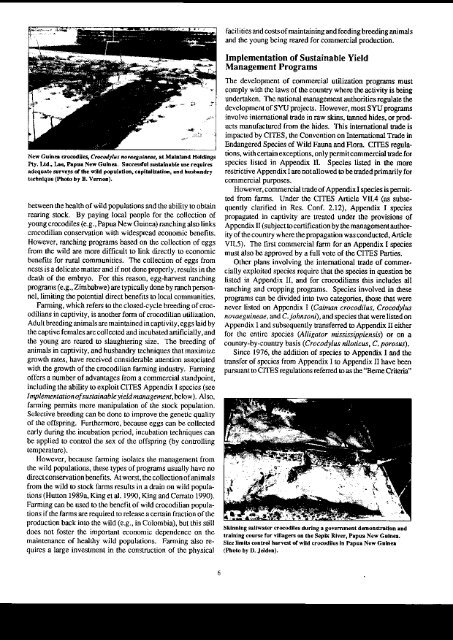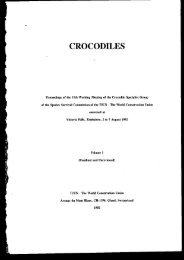size: 7451KB - Crocodile Specialist Group
size: 7451KB - Crocodile Specialist Group
size: 7451KB - Crocodile Specialist Group
Create successful ePaper yourself
Turn your PDF publications into a flip-book with our unique Google optimized e-Paper software.
facilities and cosls of mainlaining and fecding breeding animals<br />
and tho younS bcing reared for commercial Foduction.<br />
N€e Gulna ..@tlllel CeodJ&r rou.arn .., .t Mdrlrnd Holdlngs<br />
Ptt, Ltd., L.., Prpu N.r Gulno. Snc.€s{nl slsLlnrble u$ rcqulr6<br />
rdequ.te sw€ys oalh. Flld popul.llm,..plr.lL.tlm, rnd htrshndrt<br />
tachnlque (Photo br B,Vcrnd),<br />
b€(weon lhe heallh of wild populations and the abilily to obiain<br />
rcaring sbck. By paying local p€ople for thc collcction of<br />
young crocodiles (e.g., Papua New Guinea) ranching also links<br />
crocodilian consorvalion wilh widcsprcad economic benefits.<br />
However, ranching progams based on the collection of cggs<br />
from tho wild are more difficult to link dte.tly !o economic<br />
benefits for rural communirics. Thc collecrion of eggs from<br />
ncsts is a delicate matter and if not done propcrly, results in the<br />
death of ahc embryo. For this reason, egg-harvest ranching<br />
progmms (e.9., Zimbabwe) are t)?ically done by ranch penonnel,<br />
limiting lho potcntial dircct benefits to local communilies.<br />
Farming, which refers [o thc closed,cycle breeding of crocodilians<br />
in captiviry. is another form of crocodilian urilization.<br />
Adult breeding dnimals are mainlaincd in captivily, eggs laid by<br />
fie capdve females arc collcctcd ard incubated anificially, and<br />
the young arc rcarcd to slaughtering <strong>size</strong>. The breeding of<br />
animals in captivity. and husbandry techniques l.hat maximize<br />
growth rates, have reccivcd considerable attention a$ociaFd<br />
wifi the gmwlh ofth€ crocodilian fanning industry. Farming<br />
offcrs a numb€r of advanlagcs from a commercial shndpoint,<br />
including the ability to exploit CITES Appendix I spccics (see<br />
I np I e iE ntat io n of s u s tai M b ]c y i e ld nana I ene nt,lrloit). Also.<br />
farming permits more manipulation of tho stock ppulalion.<br />
Selective brceding can bc donc !o improve the genetic qualily<br />
of lhe offsp.ing. Furtlrcrmorc, bc.ause eggs can be collected<br />
carly during the incubation Brriod, incubalion iechniques can<br />
be applied !o control the sex of thc offspring (by conEolling<br />
temperalure).<br />
However, because farming isolalcs the management tiom<br />
be wild populations, these t)'pes of programs usually havc no<br />
direct conservadon b€nefits. At worst.lhc collection ofanimals<br />
from the wild to slock farms rcsults in a drain on wild populalions<br />
(Hunon 1989a, King elal. 1990, Kjng and Cenab 1990).<br />
Farrning can be used to the bencfit of wild crocodilian populalions<br />
if thc farms are requircd 10 relms€ a cortain fracdon of thc<br />
produclion back inlo thc wild (e.g., in Colombia), bul this still<br />
do€s noi foslcr lhc important economic dependcncc on the<br />
maintenance of heal&y wild populations. Farming also requircs<br />
a large investment<br />
the construction ol lhc physical<br />
Implementation of Sustainable Yield<br />
Management Programs<br />
The developmenl of commercial uiilization progmms must<br />
comply wirh thc laws of the counFy whero the activity is t€ing<br />
undertal(en, Thc nalional management audrorities rcgulale the<br />
dcvclopmcnt of SYU Fojects. However, most SYU programs<br />
involvo inlcmadonal tsade in raw skins, tanned hides, or products<br />
manufacturcd from the hides. This intemational aade is<br />
impacted by CITES, lhc Convcntion on Intemational Tmde in<br />
Endangered Species of Wild Fauna and Flora. CITES regulations,<br />
with certain exceptions, only pcrmit commercial rrade for<br />
spccics listcd in Appendi\ II. Species listed in lhe more<br />
restrictive App€ndix I are not allowed to be Eaded prirnarily for<br />
commercd purposcs.<br />
However, commercial tmdc ofAppendix I species is permitted<br />
from farms. Undcr thc CITES Anicle VII.4 (as subsoquently<br />
clarificd in Rcs. Conf. 2.12), App€ndix I species<br />
propagated in captivity are lcatcd under rhe provisions of<br />
Appcndix II (subject ro certification by &e nunagement authority<br />
of lhe counlry whcrc the propagation wai coducted, Anicle<br />
VII.s). The first commercial farm for an Appendix I speciss<br />
must also be approved by a full vote of tie CITES Parties.<br />
Olhcr plans involving $e inlernational trade of commercially<br />
exploited sp€cies requirc that the species in question bc<br />
lislcd in Appendix lI, and for crocodilians this includes all<br />
nnching and cropping programs. Species involved in rhese<br />
programs can bc divided inlo two categories, those that werc<br />
never listed on Appcndix | (Cainan crccodilus, Crocodlus<br />
novoeguineae,a C. joh^rdnr, and species thar were lis@d on<br />
App€ndix I and subsequenlly tsansfened to Appendix II either<br />
for the enlirc srf'cles (AlLigator rirsissr;a/ienrir) or on a<br />
counlry-by-counEy basis (Crocodylus niloricus, C, porosus).<br />
Sincc 1976, the addition of species l,o Appndix I and tho<br />
tmnsfcr of spccics from Appendix I to Appendix II have been<br />
pursuant io CITES regulations rcfeftd ro as the "Beme Crileria"<br />
Skhnlng srltFlt€r craodllG durln8. gove.nnentdmonshltoh nd<br />
rrrhiry(our$ ror vlll.gcE q tte S.pl* Rlyer, PtPu. N€w Guh..,<br />
Slze llmlrs sntrol hrrvEr o, $4td c.Ndlt€s l. PTur N€ycrtN.

















